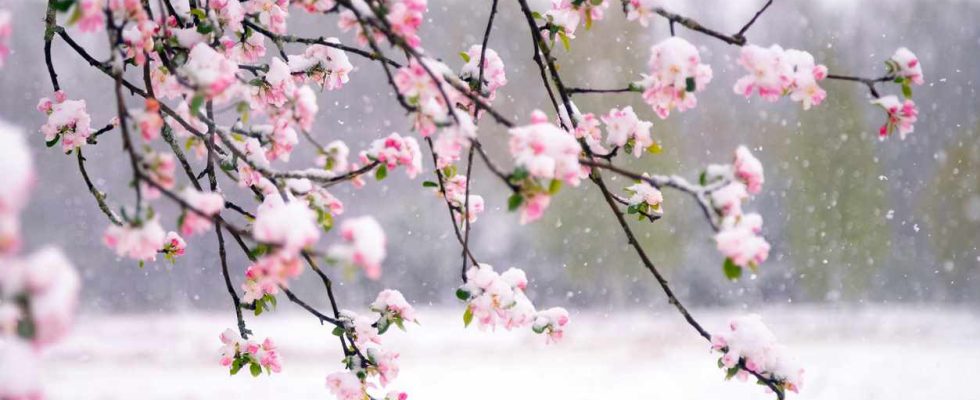
Distinguish the two types of gel
Rest assured, even if spring can be capricious and display some cool temperatures, they are not always a sign of destruction for your plants or the destruction of all your work.
You should actually know that the white frosts that you may observe in the morning do not cause significant damage, except, obviously, on very cold plants; conversely, what is to be feared are the more severe episodes. longer periods of more intense gel. This type of gel is called black gel. Let’s see what differentiates white gel from black gel:
- White frost : Quite common at the end of winter and the beginning of spring, it appears at the end of the night. This phenomenon is rarely problematic since temperatures drop slightly below 0°C for only a few hours. The damage is then limited.
- The black gel: It appears when the temperature drops significantly below 0°C for a longer period. It can be for a whole night, or even several days in a row. The most fragile parts of plants, such as buds, young shoots, flower buds, will then be irreparably damaged. You will then have to wait several weeks before the latent buds restart. Some plants do not recover from this type of frost.
Know your garden
Depending on its exposure to sun, wind, etc., each garden counts several microclimates which add to the climate of your region. It is therefore necessary to carefully observe your garden to spot them and install or protect your plants accordingly.
You have undoubtedly noticed that certain areas of your garden are cooler, while others are warmer, even if only in summer during periods of heatwave, the temperature is more bearable in certain places, or in winter , snow or frost disappears first in some other places.
Technically speaking, it is appropriate, for example, to install the orchard space in the sunniest area, but sheltered from the prevailing winds, and chilly plants to the south, ideally near a wall to protect them. Likewise, you can plant your perennials and grasses at the foot of other plants which will protect them.
Keep chilly plants sheltered
When the sun is more generous and its rays are warmer, there is a great desire to take out potted plants, such as lemon trees, olive trees, geraniums, oleanders, etc., which have been overwintered due to their reluctance, but be careful, it is necessary show patience and do not take them out too early, because it is still risky to leave them permanently outside.
You can possibly take them out on beautiful sunny days, but don’t forget to bring them in in the evening for a while longer. If the “ice saints” are generally used as reference dates to know when frosts are no longer to be feared, this period must however be adapted according to the climate in your region.
Protecting your plants: tips
Different tips allow you to protect outdoor plants from these treacherous spring frosts.
Using sails
The first solution to protect your garden from frost is to install winter sails depending on the weather forecast. You will thus be able to keep the plants, fruit trees in flower or the first seedlings which need it the most, protected from frost. But be sure to remove them as soon as the temperatures rise.
Install small protections
It is possible to create small protections for your young plants. Here are some examples:
- You can make a bell by cutting the bottom of a bottle. You then just need to place this type of bell above the plant to be protected. You can also find glass bell jars on the market. Here again, you will have to be careful not to forget it on the plant so that it does not die of suffocation.
- You can install crates upside down above your plants.
- You can make some kind of little teepees around your plants using tiles.
Create mounds
To protect your young plants, an inexpensive solution is to create mounds. To do this, simply raise the earth in the shape of a mound at the foot of the plants. You can opt for this solution for your perennial plants, your rose bushes, but also your stem or bulb vegetables. The earth then acts as a thermal insulator.
Protect with mulch
A very effective solution to protect your plants from frost is to use mulch. It can be straw, dead leaves, branches, etc., or even cardboard. This mulch will allow you to protect the roots of the most fragile plants until warmer temperatures return. At this time you will need to remove it to allow the floor to warm up more quickly.
Growing in pots
It is much preferable to grow plants that are more chilly or less adapted to the climate of your region in pots. So, as soon as the temperatures drop, you just need to shelter them in a cool, bright room, without pressing them too closely together to ensure good ventilation.
Do not water
When meteorologists announce the arrival of low temperatures, avoid watering your plants, because, by stagnating in the soil, this water could turn into ice and destroy the roots of your plants. If your plants need watering and the temperature is above 0°C, make sure to do it in the morning. The water will then have plenty of time to pass through the soil or substrate before the next frost occurs.
Choose your plants wisely
When purchasing plants, it is essential to choose plants adapted to the climate of your geographical area. For example, if you live in an area where the risk of frost is high in spring, opt for late-growing perennials, trees and shrubs. This will help you avoid complications related to freezing.

